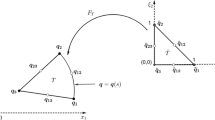Abstract
Numerical solutions of low-frequency electromagnetic problems are not a simple task, due to the inherent nature of their electrically small structures. The wavelength is very small relative to the size of the objects considered in these problems. Therefore, extremely fine meshes have to be used in the numerical solutions to perform accurate geometrical modeling of the scatterers and/or antennas. This requires extremely small unit time steps to preserve the stability of time-domain methods such as FDTD. As a result, a huge number of time iterations are required, leading to long and unacceptable computation times for today’s computer technology. Although different modifications of the FDTD algorithms have been proposed to overcome this limitation, additional speed-up techniques are needed to further reduce the computation times. The two-equations two-unknowns (2E-2U) method is a good candidate for this purpose. In this study, error analyses of the 2E-2U method for low-frequency FDTD solutions are performed in detail, and an illustrative three-dimensional scattering problem of a dielectric sphere is solved for this purpose. Critical cases for the efficient application of the 2E-2U method are clearly revealed, and some important topics are highlighted.






Similar content being viewed by others
Notes
The transient oscillations mainly originate from rapid transitions of source waveforms such as sharp leading edges of the source signals and/or discontinuous interfaces of the media such as scatterers and absorbing boundary conditions [14].
In fact, there is a misprint in [8] as \(\theta =\tan ^{-1}[q_2\sin (\omega t_1) -q_1\sin (\omega t_2)+q_1\sin (\omega t_2)-q_2\sin (\omega t_1)]\).
References
Gupta, B., Ducharne, B., Sebald, G., Uchimoto, T.: A space discretized ferromagnetic model for non-destructive eddy current evaluation. IEEE Trans. Magn. 54–3, 6200204 (2018)
Feng, N., Zhang, Y., Sun, Q., Zhu, J., Joines, W.T., Liu, Q.H.: An accurate 3-D CFS-PML based Crank–Nicolson FDTD method and its applications in low-frequency subsurface sensing. IEEE Trans. Antennas Propag. 66–6, 2967–2975 (2018)
Özakın, M.B., Aksoy, S.: Application of magneto-quasi-static approximation in the finite difference time domain method. IEEE Trans. Magn. 52–8, 7209809 (2016)
Gaffar, M.D., Jiao, D.: On the low-frequency breakdown of FDTD. In: IEEE International Symposium on Antennas and Propagation, Vancouver, BC, Canada, pp. 338–339 (2015)
Zhou, L., Xi, X., Du, Y.: Application in low-frequency ground-wave propagation of parallel FDTD based on GPU, In: 10th International Symposium on Antennas, Propagation and EM Theory, Xian, China, pp. 917–920 (2012)
Gandhi, O.P., Chen, J.Y.: Numerical dosimetry at power-line frequencies using anatomically-based models. Bioelectromagn. Suppl. 1, 43–60 (1992)
Cangellaris, A.C., Gribbons, M., Sohos, G.: A hybrid spectral/FDTD method for the electromagnetic analysis of guided wave structures. IEEE Microw. Guided Wave Lett. 3–10, 375–377 (1993)
Furse, C.M., Gandhi, O.P.: Calculation of electric fields and current induced in a millimeter-resolution human model at 60 Hz using the FDTD method with a novel time-to-frequency-domain conversion. In: International Antennas and Propagation Symposium Digital Baltimore, vol. 3, pp. 1798–1801 (1996)
Furse, C.M.: Application of the finite-difference time-domain method to bioelectromagnetic simulations. Appl. Comput. Electromagn. Soc. Newslett. 12–1, 28–57 (1997)
Furse, C.M., Gandhi, O.P.: Calculation of electric fields and currents induced in a millimeter-resolution human model at 60 Hz using the FDTD method. Bioelectromagnetics 19, 293–299 (1998)
Furse, C.M.: Faster than Fourier—ultra-efficient time-to-frequency domain conversions for FDTD. In: Applied Computational Electromagnetics Society Symposium, Monterey, CA, pp. 536–539 (1998)
Furse, C.M.: Faster than Fourier: ultra-efficient time-to-frequency domain conversions for FDTD. IEEE Antennas Propag. Mag. 42–6, 24–33 (2000)
Liu, F., Croizer, S., Zhao, H.: Finite-difference time-domain-based studies of MRI pulsed gradient-induced eddy currents inside the human body. Concepts Magn. Reson. Part A 15–1, 26–36 (2002)
Zhao, H., Croizer, S., Liu, F.: A high definition finite difference time domain method. Appl. Math. Model. 27–5, 409–419 (2003)
Chakarothai, J., Wake, K., Watanabe, S.: Convergence of a single-frequency FDTD solution in numerical dosimetry. IEEE Trans. Microw. Theory Techn. 64–3, 707–714 (2016)
Liu, J.X., Ju, L., Liu, Y.J., Xu, Z.G., Yang, H.W.: FDTD method for the scattered-field equation to calculate the radar cross-section of a three-dimensional target. J. Comput. Electron. 17, 1013–1018 (2018)
Rahhal-Arabi, A., Mittra, R.: An alternate form of the MUR second-order absorbing boundary condition. Microw. Opt. Technol. Lett. 9–6, 336–338 (1995)
Author information
Authors and Affiliations
Corresponding author
Additional information
Publisher's Note
Springer Nature remains neutral with regard to jurisdictional claims in published maps and institutional affiliations.
Rights and permissions
About this article
Cite this article
Saydam, T., Aksoy, S. Error analyses of the two-equations two-unknowns method for low-frequency FDTD problems. J Comput Electron 19, 1573–1578 (2020). https://doi.org/10.1007/s10825-020-01536-z
Published:
Issue Date:
DOI: https://doi.org/10.1007/s10825-020-01536-z




